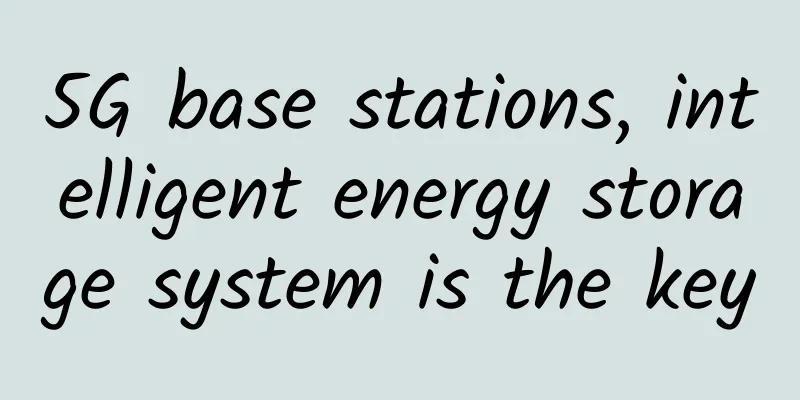5G base stations, intelligent energy storage system is the key

|
Large-scale 5G construction has begun. As the basic guarantee for the operation of 5G base stations, are power supply and backup power ready? Is the site's mains power capacity sufficient? Isn't it time-consuming, labor-intensive and costly to expand the mains power capacity? Is the site energy storage system large enough? Is there no room in the computer room to expand the energy storage? Can the problem of repeated theft of energy storage batteries causing base station outages and maintenance personnel running around be solved? In the 5G era, networks are more complex and consume more energy. How can we finely manage base station energy storage to reduce costs and increase efficiency? … Will ordinary energy storage systems work? As we all know, the number of antenna channels and site capacity of 5G equipment has increased significantly, resulting in an increase in the overall power consumption of base stations. The power supply and backup power of 5G base stations need to be upgraded and expanded. As a key component of the energy storage system, traditional lead-acid batteries are large and heavy, and the limited machine room and site space can no longer accommodate so many batteries. In the energy storage system, it is a general trend to replace lead-acid batteries with lithium batteries that are smaller, lighter, have higher energy density, longer life, and better performance.
But can the problem be solved by using ordinary lithium batteries instead of lead-acid batteries? Although lithium batteries have been widely used in industries such as electric vehicles and terminal equipment, and in the 4G era, they were also partially used in operator site energy storage systems. However, in the 5G era, the communication base station environment is more complex and the requirements are more stringent. It is not enough to simply use ordinary lithium batteries to replace lead-acid batteries in energy storage systems. First of all, as a key component in the energy storage system, ordinary lithium batteries are just a simple combination of battery cells and structural parts, with only simple backup power functions, no coordination, no management or rough management, which will cause problems such as waste of resources, high evolution costs, and difficult operation and maintenance, and cannot meet the new needs of the 5G era. Secondly, the traditional base station energy storage system consists of multiple single cells forming a battery pack, which works in parallel. If the internal resistance and capacity of the battery are different, there will be bias current when the battery is charged and discharged, which will affect the battery life. For this reason, new and old batteries or different types of batteries cannot be directly mixed and used, resulting in the need to replace the existing batteries in the energy storage system when expanding the capacity, and the old batteries cannot be reused, resulting in serious waste of resources and increased investment costs. Adding a battery combiner to achieve mixing will lead to excessive CAPEX and more failure points. If the bias current is too large, overcurrent protection will occur, causing the battery pack to shut down and be unable to supply power. For this reason, the industry generally prevents overcurrent by adding batteries, but this also wastes resources and increases floor space. Then there is the issue of safety. The anti-theft protection of the site energy storage system is really a headache. The answer is obvious. The energy storage system using ordinary lithium batteries cannot meet the specific needs of the communications industry in the 5G era. what to do? The times call for intelligent energy storage systems What is a smart energy storage system? Unlike ordinary energy storage systems, intelligent energy storage systems integrate communication technology, power electronics technology, sensing technology, high-density technology, high-efficiency heat dissipation technology, AI technology, cloud technology and lithium battery technology. Looking to the future, the intelligent energy storage system will have a three-tier architecture consisting of local BMS, energy IoT networking, and cloud BMS. Based on big data analysis and AI algorithms, it will meet the new demands for comprehensive energy storage applications, intelligent collaboration, refined management, and full-scenario applications in the 5G era through intra-station collaboration, inter-station collaboration, and station-network collaboration of the energy storage system. In response to the multi-dimensional demands for site energy storage in the 5G era, Huawei has launched the 5G Power intelligent energy storage system based on its deep understanding of the 5G network evolution trend. It mainly has the following features: (1) Basic lithium battery functions with better performance It adopts the industry's highest-density design, is small in size and light in weight, and only requires 3.6U for 150Ah capacity. One cabinet can accommodate 600Ah. It can replace old lead-acid batteries in situ without adding cabinets, solving the headache-inducing problems that the telecommunications industry has long faced, such as difficulty in acquiring sites, high site rents, and slow project progress. Based on sensing, communication, AI and cloud technologies, it can detect and manage voltage, current, temperature and balancing functions in real time, realize automatic protection and high-precision balancing of overvoltage/undervoltage, overcurrent and high temperature/low temperature, improve battery efficiency, reduce operation and maintenance costs, and ensure 100% safety. Even in the event of a fire caused by extreme external reasons, the intelligent lithium battery can 100% self-extinguish the fire, meeting the ultimate safety requirements of the communication room. (2) In-site collaboration: intelligent boosting, intelligent mixing, and intelligent anti-theft Through on-site collaboration between the local BMS and site subsystems, the energy storage system can be transformed from single backup power to comprehensive application, and from no collaboration to intelligent collaboration, thereby improving investment efficiency and releasing asset value. As we all know, when current flows through cables and connectors, it will cause line loss and voltage drop. The longer and thinner the cable, the greater the current and the greater the voltage drop. Due to the increased power consumption of 5G AAU, if the original -48V power supply is used, in order to meet the power requirements of the AAU equipment, the required current will be greater, resulting in greater voltage drop and shorter power supply distance, which cannot meet some AAU remote scenarios and wastes energy. In order to solve this problem, operators have to replace thicker power cables, but this brings new problems - the thicker the power cable, the heavier the weight, the higher the cost, and it will cause the tower to exceed the load-bearing capacity. The voltage of traditional energy storage systems will gradually decrease as the battery discharges, and may even cause a voltage drop, which poses a greater challenge to the stability of 5G power supply. The intelligent energy storage system works in conjunction with the 5G power supply. The discharge capacity of a 100Ah smart lithium battery is equivalent to that of a 200Ah ordinary lithium battery or lead-acid battery. It supports 57V constant voltage output, does not require thick cables, and releases 100% of the power, which can increase the site power supply distance and reduce battery investment. In view of the problem of bias current caused by mixing old and new batteries or different types of batteries, the intelligent energy storage system can realize intelligent coordination between different battery groups and power supplies, and intelligently regulate the bias current and circulating current between battery groups to achieve intelligent parallel operation without loss of output power. Taking the typical 8kW power consumption 1h backup power scenario as an example, the industry's ordinary energy storage system needs to be configured with 4 groups of 100Ah lead-acid or lithium batteries, while the intelligent energy storage system only needs to be configured with 2 groups of 100Ah intelligent lithium batteries, saving 2 groups of batteries and 1 cabinet, thereby reducing the land occupation and reducing site rent. The intelligent energy storage system can also automatically adapt to the voltage of different battery packs, eliminating the need to add combiners and lead-acid batteries, and intelligently mix old and new lithium batteries to maximize the use of existing batteries, thus protecting assets and reducing the step-by-step investment in 5G evolution. At the same time, in response to the problem of frequent battery thefts, the smart energy storage system can achieve online smart software lock anti-theft, offline smart displacement lock anti-theft and GPS positioning tracking through intelligent collaboration with the power supply and network management, thereby minimizing the loss caused by theft. (3) Inter-station/station-network collaboration: intelligent peak shaving, intelligent peak shifting, and fine management of the entire network The introduction of 5G equipment to base station sites will result in insufficient capacity for external mains power, which requires expansion and reconstruction of the mains power supply. However, mains power reconstruction projects often have long cycles and high costs. Through intelligent network management and intelligent grid collaboration, the state of the energy storage system is intelligently analyzed. When the load peaks, the intelligent energy storage system participates in the load power supply to achieve "intelligent peak shaving", thereby achieving "unchanged mains power" evolution to 5G, reducing investment and accelerating 5G deployment. With the intelligent coordination of intelligent network management and power grid and the high cycle performance of intelligent lithium batteries, it is also possible to charge during low electricity price periods and discharge during high electricity price periods through "intelligent peak shifting", thereby saving electricity bills and activating the value of batteries. Looking to the future, through energy IoT, energy storage systems equipped with smart lithium batteries and intelligent collaboration with network management, the energy storage system of the entire network can be visualized, manageable and controllable; through big data and AI analysis and prediction, forward-looking operation and maintenance and inter-station battery resource complementarity can be achieved, thereby reducing operation and maintenance costs and reducing resource waste. That’s right, ordinary energy storage systems alone can no longer meet the new demands of the 5G era. The times call for smart energy storage systems equipped with smart lithium batteries. In fact, most operators around the world have gone from calling to action and are actively deploying smart energy storage systems. From calling to action, global operators choose smart energy storage systems Operators in countries such as Saudi Arabia and the United Arab Emirates have begun building 5G networks. Like any other operator in the world, these operators have also encountered problems such as insufficient mains capacity, insufficient battery backup power, and limited space for adding new cabinets at sites in 5G construction. To this end, these operators have adopted Huawei's 5G Power intelligent energy storage system, which can smoothly expand 5G backup power without adding new cabinets, and can evolve to 5G "without changing the mains or cables" through "intelligent peak shaving" and "intelligent boosting" technologies, thereby achieving economical, efficient and rapid deployment of 5G. In some countries, smart energy storage systems have also solved the problem of frequent battery thefts. For example, the annual average theft rate of TIM's base stations in Brazil is 15%, which has caused huge economic losses and increased operation and maintenance costs. Since the adoption of Huawei's 5G Power smart energy storage system, once the battery is stolen or abnormal, an alarm will appear on the network management side, and the lithium battery will be automatically locked and lose its value, solving the theft problem from the root cause. An overseas colleague told an interesting real case. One of their base stations was looted by thieves, and even the main equipment was not spared. However, when the scene was cleaned up, it was found that Huawei's smart energy storage system was still there. Another interesting case is Portugal Telecom. In the EU, considering national purchasing power, Portugal is the country with the most expensive electricity bills and adopts a tiered electricity price. In order to reduce electricity expenses, Portugal Telecom adopted Huawei's 5G Power intelligent energy storage system. Through "intelligent peak shifting", when the mains electricity price is high, it automatically reduces the mains power supply and starts lithium battery discharge; when the mains electricity price is low, it uses the mains power supply and charges the 5G Power intelligent energy storage system as an energy buffer pool, thereby effectively balancing the mains price difference and reducing site electricity costs. |
Recommend
Top 10 SDN Solutions of 2018 (So Far)
Software is the front and center of the network w...
How did TA succeed in intercepting tens of millions of malicious addresses?
Want to self-check and improve your cybersecurity...
Hand-write a Nodejs program that imitates WeChat login
[[357291]] Preface First, let’s take a look at a ...
Sharktech: Los Angeles high-defense server 1Gbps unlimited traffic starting at $129/month, optional 10Gbps unlimited traffic
Sharktech is a long-established foreign hosting c...
Analysis of the operating data of the three major operators in August: 5G users have entered a golden growth period
Recently, the three major operators released thei...
Channels: Operators’ Breakthrough Skills in the 5G Era
An operator executive once believed that user gro...
[Understand Routing in Seconds] Now that we have an IP address, is a MAC address still necessary?
I wonder if you are confused: Why do we need a MA...
Behind the surging IPv6, how much do you know about the DHCPv6 protocol?
With the popularization of IPv6 technology, DHCPv...
RackNerd: New Year 2024 series starting at $10.99/year, multiple data centers in Los Angeles, San Jose, etc.
RackNerd New Year 2024 packages are divided into ...
What factors should be considered when designing a high-performance and high-concurrency network system? (10,000-word article)
[[271144]] "There are few things in the worl...
How do IDC, CDN, and cloud service providers upgrade to IPv6?
With the rapid development of the Internet, IPv4 ...
Why is it not appropriate to implement "one price for data traffic nationwide" at present?
According to the 21st Century Business Herald, &q...
5G message is coming, please check!
What is 5G messaging? Is it an upgraded version o...
How the wireless network market will develop in 2022
A wireless network is a computer network that re...
Analysis on the development prospects of China's medical information industry during the 13th Five-Year Plan
The development stage of medical informationizati...









